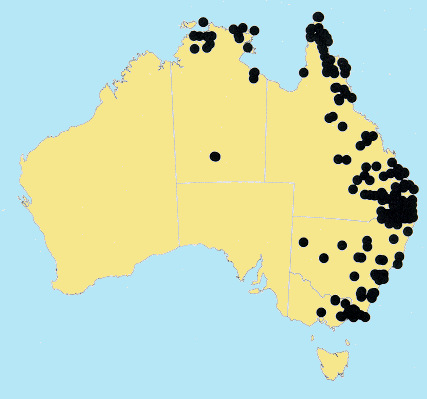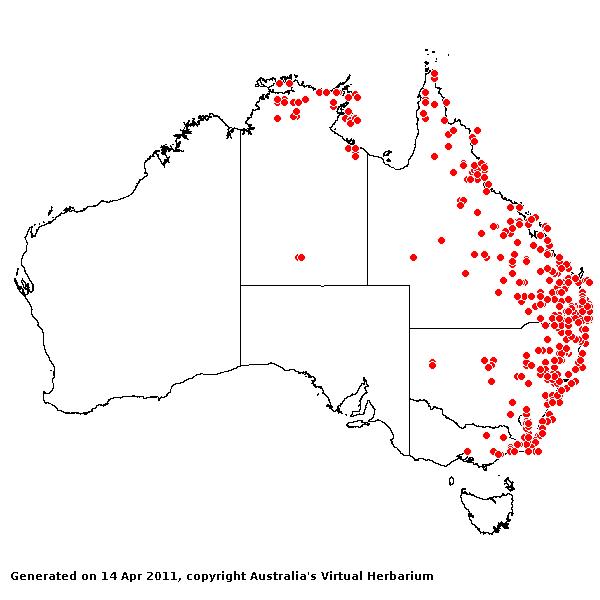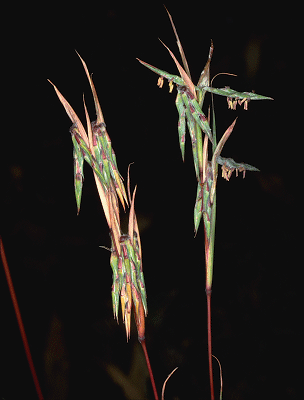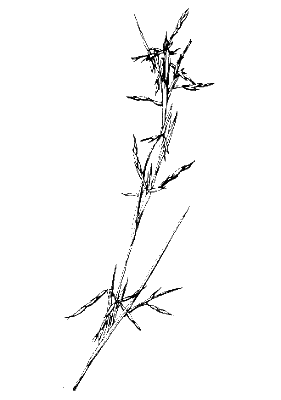Cymbopogon refractus (R.Br.) A. Camus. Rev.
Int. Bot. App. Agric.Trop. 1: 279 (1921).
Classification.
(GPWG 2001) : Subfamily Panicoideae. Andropogoneae.
Basionym and/or
Replacement Name: Andropogon
refractus R. Br., Prodr. 1: 202 (1810).
Type of Basionym or
Protologue Information: HT: R. Brown 6177, Australia: New South
Wales: Port Jackson (BM; IT: E, K, P).
Key references
(books and floras): [1810]. R.Brown, Prodromus (202 as Andropogon
refractus), [1878] G.Bentham, Flora Australiensis 7 (534 as Andropogon
refractus), [2002] D.Sharp & B.K.Simon, AusGrass, Grasses of
Australia, [2008] S.W.L.Jacobs, R.D.B.Walley & D.J.B.Wheeler, Grasses
of New South Wales (191).
Illustrations:
[1983] J.C.Tothill & J.B.Hacker, Grasses of Southern Queensland
(170), [1984] N.T.Burbidge. rev. S.W.L.Jacobs, Australian Grasses (95), [2008] S.W.L.Jacobs, R.D.B.Whalley &
D.J.B.Wheeler, Grasses of New South Wales, 4th edn (191).
Habit.
Perennial. Culms erect, 30–150 cm tall, 2–3 -noded. Mid-culm nodes glabrous.
Ligule an eciliate membrane, 1–2 mm long. Leaf-blades flat or revolute, 10–40
cm long, 1–4 mm wide. Leaf-blade surface scabrous.
Inflorescence.
Inflorescence compound, composed of rames. Central inflorescence axis 10–45 cm
long. Rhachis fragile at the nodes.
Spikelets.
Spikelets sessile, 1 in the cluster. Companion spikelets pedicelled, 1 in the
cluster. Basal sterile spikelets represented by a single scale, 2 in number
(lower raceme). Companion spikelets developed, comprising 2 unequal glumes
without lemmas, 4–6 mm long. Companion spikelet glumes pungent. Fertile
spikelets 2-flowered, the lower floret barren (rarely male), the upper fertile,
comprising 1 basal sterile florets, comprising 1 fertile floret(s), without
rachilla extension, lanceolate or elliptic or ovate, dorsally compressed, 4.5–7
mm long.
Glumes. Glumes
dissimilar, firmer than fertile lemma. Lower glume lanceolate, chartaceous,
keeled, 2-keeled, wingless, 3–5 -nerved. Upper glume lanceolate, chartaceous,
keeled, 1-keeled, 3–7 -nerved. Florets. Basal sterile florets 1, barren,
without significant palea. Lemma of lower sterile floret hyaline, 1 -nerved.
Fertile lemma 3.5 mm
long, without keel. Lemma apex entire or dentate, mucronate or awned, 1 -awned.
Median (principal) awn from a sinus, 0–12 mm long overall, without a column.
Palea absent. Anthers 3. Grain 2.5 mm long.
Continental
Distribution: Australasia and Pacific.
Australian
Distribution: Northern Territory, Queensland, New South Wales, Victoria,
A.C.T., Norfolk I.
Northern Territory:
Darwin & Gulf. Queensland: Burke, Burnett, Cook, Darling Downs,
Leichhardt, Maranoa, Mitchell, Moreton, North Kennedy, Port Curtis, South
Kennedy, Warrego, Wide Bay, Gregory North. New South Wales: North Coast,
Central Coast, South Coast, Northern Tablelands, Central Tablelands, Southern
Tablelands, North-Western Slopes, Central-Western Slopes, North-Western Plains,
North Far Western Plains. Victoria: East Gippsland, Eastern Highlands,
Gippsland Plain, Midlands, Volcanic Plain.
Notes.
Widespread in the Eucalyptus forests and woodlands of eastern Australia,
especially on lighter soils of low fertility; rare in northern N.T. It has
become naturalised over a fairly wide area in the Pacific (Norfolk I., New
Caledonia, Vanuatu, Fiji, Samoa, Tonga, Cook Is, Hawaii, Society Is, Tahiti and
Tuamotu Archipelago). Cultivated for forage in Niihau (Hawaai). Flowers all
year.






